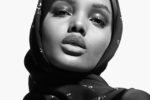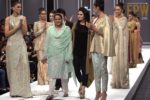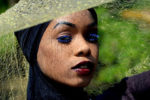If a hijab in Pucci-designed print could speak, what would it say?
I attended a seminar presented by Professor Reina Lewis on Muslim women’s lifestyle magazines last night and was faced with this bizarre question. It all started with the actual seminar itself, which showcased the latest research adventures of the fashion and design professor. Weaving together previous work that included alternative Orientalist narratives in the 19th century and queer lifestyle magazines, Lewis’ paper focused on the Muslim women’s magazines that emerged at a crucial time (post-9/11) when more positive representations of Muslims were needed in a Western public discourse that had none. And the so usual suspects were mentioned: emel, Sisters, Muslim Girl, Azizah, and an anomaly, Alef–being the only one that didn’t try hard to get a particularly Muslim lifestyle look.
Having the enviable position of fashion professor, Lewis was more interested in how women/the human form were presented the magazines, what Islamic fashion is really all about, and the advertising contained within the magazines than the content. For her, visual representation in print media of women who were getting more covered up than their mothers, grandmothers, and their non-Muslim peers was striking and counter-cultural.

A fashion advertisement in Istanbul, Turkey.
The same way Nylon and Harper’s Bazaar are different from each other in presentation and content, Muslim lifestyle magazines set themselves apart in these ways too, but addition to that the magazines self-define or defined by others as either “Muslim” or “Islamic”. emel, Lewis said, is a “Muslim” magazine in that it reaches out to an audience of diverse backgrounds and levels of religiosity, while Azizah is more “Islamic” because it caters to a more conservative readership. It’s hard to not find these labels contentious as they could lead to a series of polemical questions, like, is emel less Islamic than say, Azizah or can a lifestyle magazine as a guide help a reader gain a more Islamic look?
Of course the latter is a silly question, but having read fashion and lifestyle magazines myself before I’d say that there is a level of self-identification in (a few of) the models and the “I am what I buy” ethos that is much invested in brand advertising today. And so for attaining the trendy or at least up-to-date Muslimah look, one only need to look at what other people are wearing, and simply flick through magazines for reference.
During the Q & A session, someone from Saudi Arabia had asked a thought-provoking question about the real purpose of fashion in faith-based women’s magazines. It was a question that I had pondered over a long time ago when I decided on two things: to not be a follower of fashion and not to wear the hijab. The question goes something like this, “If fashion is about self-expression and to a large extent ‘being noticed’, how does Islamic dressing and the fickle world of fashion reconcile with the concept of modesty and inconspicuousness?” I remember the days when I had to wear the hijab in college and becoming the object of male attention which made me uncomfortable. Without the hijab, I found to my relief that the unwanted attention seemed to have lessened, but this had nothing to do with how much skin I was showing with or without the hijab, rather the headscarf became a marker of what good young Muslim men found attractive. This was when I learned that the hijab had more complex meanings.
This brings me back to the rhetorical Pucci headscarf and what modesty means to different Muslim women. In addition to being a symbol of devotion, modesty, and cultural identity, the hijab today has taken an extra meaning, one that fits nicely with the global consumer culture and current trends. The hijab as represented even in the most conservative Islamic women’s magazines often doubles up as a fashion accessory.
Not to sound overly fussy, but isn’t being fashionable attention-grabbing and hence immodest? I need to mention again that I am not into lifestyle magazines, fashion, and do not wear the headscarf, so I’m perhaps the least equipped person to explain whether Islamic fashion is modest or not. At the same time I think my assumptions that modesty clashes with fashion is probably unfounded, too.
What are your thoughts?



